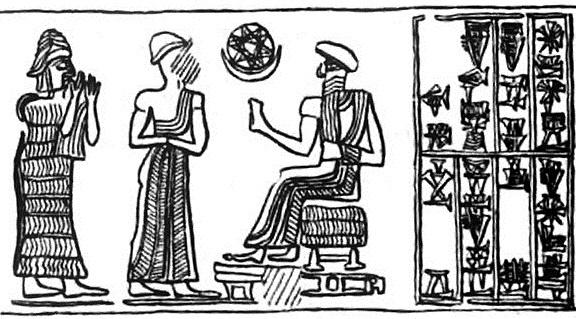
| PARSHURAM / BUR-SIN - I
Cylinder seal of Bur-Sin
Parshuram / Bur-Sîn (inscribed bur-EN.ZU), c. 1831 – 1811 BC (short chronology) or c. 1895 – 1874 BC (middle chronology) was the 7th king of the 1st Dynasty of Isin and ruled for 21 years according to the Sumerian King List, 22 years according to the Ur-Isin king list. His reign was characterized by an ebb and flow in hegemony over the religious centers of Nippur and Ur.
Biography
:
He was contemporary with the tail end of the reign of Abi-sare, ca, 1841 to 1830 BC (short) and that of Sumú-El, c. 1830 to 1801 BC (short), the kings of Larsa. This latter king’s year-names record victories over Akusum, Kazallu, Uruk (which had seceded from Isin), Lugal-Sîn, Ka-ida, Sabum, Kiš, and village of Nanna-isa, relentlessly edging north and feverish activity digging canals or filling them in, possibly to counter the measures taken by Bur-Sîn to contain him. Only nine of Bur-Sîn's own year-names are known and the sequence is uncertain. He seized control of Kisurra for a time as two year-names are found among tablets from this city, possibly following the departure of Sumu-abum / Sumu-abu / Su-abu / Subahu the king of Babylon who “returned to his city.” The occupation was brief, however, as Sumu-El was to conquer it during his fourth year. Other year-names record Bur-Sîn's construction of fortifications, walls on the bank of the Eurphrates and a canal. A year-name of Sumu-El records “Year after the year Sumu-El has opened the palace (?) of Nippur,” whose place in this king’s sequence is unknown.
A red-brown agate statuette was dedicated to goddess Inanna and an agate plate was dedicated by the lukur priestess and his “traveling companion,” i.e. concubine, Nanaia Ibsa. A certain individual by the name of Enlil-ennam dedicated a dog figurine to the goddess Ninisina for the life of the king. There are around five extant seals and seal impressions of his servants and scribes, three of which were excavated in Ur suggesting a fleeting late reoccupancy of this city at the end of his reign and the beginning of his successor's as coincidentally no texts from Ur bear Sumu-El's years 19 to 22 which correspond with this period.
Source :
https://en.wikipedia.org/ |
